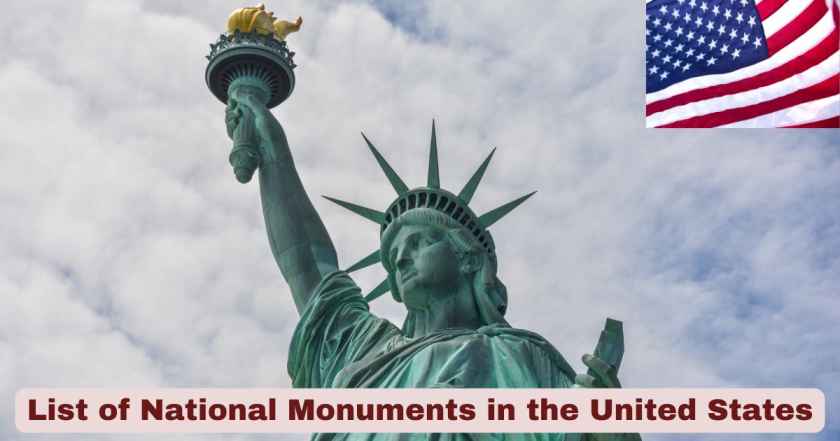The United States is home to an extraordinary collection of protected landscapes, archaeological sites, and historically significant areas that tell the story of America’s natural and cultural heritage. This comprehensive guide explores the complete list of national monuments in the United States as of 2025, providing essential information for travelers, historians, and nature enthusiasts alike.
1. National Monuments in the United States
| Key Statistics | Details |
|---|---|
| Total Number of National Monuments in the US | 138 |
| States with National Monuments | 32 |
| Additional Territories | District of Columbia, Virgin Islands, American Samoa, Minor Outlying Islands, Northern Mariana Islands, Atlantic Ocean |
| Primary Legislation | Antiquities Act of 1906 |
| Authority to Designate | President by proclamation, Congress by legislation |
| First National Monument | Devils Tower (1906) |
| Most Recent Designations | Chuckwalla and Sáttítla Highlands (January 2025) |
| Managing Agencies | National Park Service, Bureau of Land Management, U.S. Forest Service, U.S. Fish and Wildlife Service |
| Total Protected Acreage | Over 373 million acres |
National monuments represent some of America’s most treasured and protected landscapes, preserving everything from ancient Native American ruins to stunning natural formations and important historical sites. The United States has 138 protected areas known as national monuments, making them a significant component of the country’s public lands system.
The authority to create national monuments stems from the Antiquities Act of 1906, which grants the president extraordinary power to protect areas of national significance. The president of the United States can establish a national monument by presidential proclamation, and the United States Congress can do so by legislation. This legislation was specifically designed to protect prehistoric Native American ruins and artifacts, but has since expanded to encompass a wide variety of natural and cultural treasures.
The scope and diversity of national monuments is truly remarkable. National Monuments of the United States exist in 32 States, the District of Columbia, Virgin Islands, American Samoa, Minor Outlying Islands, Northern Mariana Islands and the Atlantic Ocean. This geographic distribution ensures that Americans across the country have access to these protected areas.
2. Facts About National Monuments in the United States
| Notable Facts | Information |
|---|---|
| States with Most Monuments | Arizona and California (18 each) |
| Largest Monument | Papahānaumokuākea Marine National Monument (372,848,597 acres) |
| Smallest Monument | Thaddeus Kosciuszko National Memorial (0.02 acres) |
| Newest Monuments (2025) | Chuckwalla and Sáttítla Highlands National Monuments |
| Total Acreage Added in 2025 | Over 840,000 acres |
| Average Annual Visitors | Over 25 million across all monuments |
| Oldest Continuously Protected | Devils Tower (since 1906) |
| Most Visited Monument | Statue of Liberty National Monument |
| Marine Monuments | 5 designated marine national monuments |
| UNESCO World Heritage Sites | Several monuments also hold UNESCO status |
| Economic Impact | Contributes billions annually to local economies |
| Management Changes | Some monuments transferred between agencies or redesignated |
Understanding the fascinating facts about national monuments helps appreciate their significance in American conservation and cultural preservation. These protected areas showcase remarkable diversity in size, purpose, and management approaches.
Arizona and California lead the nation in the number of national monuments. Of all the states Arizona and California have the most National Monuments at 18. This concentration reflects the rich archaeological heritage of the Southwest and California’s diverse ecosystems and geological formations.
The size range of national monuments is extraordinary, from small historic sites to vast wilderness areas. Papahānaumokuākea Marine National Monument is the largest national monument in the world and also the largest protected area on the planet at 372,848,597 acres. This Hawaiian marine monument protects one of the world’s most pristine coral reef ecosystems.
Recent additions continue to expand the national monument system. Sáttítla Highlands National Monument, established in January 2025, covers almost 225,000 acres of volcanic terrain and diverse landscapes in the foothills of California’s Mount Hoffman, while President Biden designated two new national monuments – the Chuckwalla and Sáttítla National Monuments. This adds protections to more than 840,000 acres of some of the state’s most culturally and environmentally significant landscapes.
3. List of National Monuments in the United States
| Monument Categories | Examples | Number of Sites | Primary Features |
|---|---|---|---|
| Archaeological Sites | Mesa Verde, Canyon de Chelly, Chaco Culture | 25+ | Ancient ruins, petroglyphs, cultural artifacts |
| Natural Landmarks | Devils Tower, Rainbow Bridge, Muir Woods | 30+ | Unique geological formations, old-growth forests |
| Marine Areas | Papahānaumokuākea, Northeast Canyons and Seamounts | 5 | Coral reefs, marine ecosystems, underwater canyons |
| Historic Sites | Statue of Liberty, Fort Sumter, Stonewall | 40+ | Battlefields, presidential sites, civil rights locations |
| Geological Features | Giant Sequoia, Fossil Butte, John Day | 20+ | Rock formations, fossil deposits, volcanic features |
| Paleontological Sites | Dinosaur, Fossil Butte, Hagerman Fossil Beds | 8+ | Dinosaur fossils, ancient life forms, geological history |
The complete list of national monuments encompasses diverse categories including archaeological sites, natural landmarks, marine areas, and historic structures. Each monument tells a unique story about America’s heritage and natural wonders.
Archaeological and prehistoric sites form a significant portion of national monuments, protecting ancient Native American ruins, petroglyphs, and cultural landscapes. These sites preserve thousands of years of human history and continue to hold deep spiritual significance for tribal communities.
Natural monuments protect unique geological formations, ecosystems, and scenic landscapes that might otherwise be vulnerable to development or degradation. From towering rock formations to pristine forests, these areas showcase America’s natural diversity.
Marine national monuments represent some of the newest and largest protected areas, safeguarding ocean ecosystems, coral reefs, and marine wildlife. These underwater treasures are crucial for maintaining healthy ocean environments and supporting marine biodiversity.
Historic monuments commemorate important events, people, and structures that shaped American history. From battlefields to presidential homes, these sites help visitors connect with the nation’s past.
4. Top 20 Most Famous National Monuments in the United States
| Rank | Monument Name | Location | Annual Visitors | Key Features |
|---|---|---|---|---|
| 1 | Statue of Liberty | New York | 4.3 million | Symbol of freedom, Ellis Island, crown access |
| 2 | Castillo San Cristóbal | Puerto Rico | 1.6 million | Spanish colonial fortress, tunnels |
| 3 | Fort McHenry | Maryland | 1.2 million | Star-Spangled Banner birthplace |
| 4 | Muir Woods | California | 1 million+ | Ancient coast redwood forest |
| 5 | Canyon de Chelly | Arizona | 800,000+ | Native American ruins, living culture |
| 6 | Cabrillo | California | 700,000+ | Pacific Ocean views, tide pools |
| 7 | Bandelier | New Mexico | 600,000+ | Ancestral Puebloan cliff dwellings |
| 8 | Fort Sumter | South Carolina | 550,000+ | Civil War fort, harbor setting |
| 9 | Devils Tower | Wyoming | 500,000+ | First national monument, rock climbing |
| 10 | Casa Grande Ruins | Arizona | 450,000+ | Hohokam four-story structure |
| 11 | Montezuma Castle | Arizona | 400,000+ | Sinagua cliff dwelling, well-preserved |
| 12 | Fort Stanwix | New York | 350,000+ | Revolutionary War fort reconstruction |
| 13 | George Washington Birthplace | Virginia | 300,000+ | Colonial plantation, memorial house |
| 14 | Dinosaur | Colorado/Utah | 275,000+ | Fossil exhibits, river rafting |
| 15 | Natural Bridges | Utah | 250,000+ | Three natural sandstone bridges |
| 16 | Chiricahua | Arizona | 225,000+ | Rock pinnacles, hiking trails |
| 17 | Wupatki | Arizona | 200,000+ | Sinagua pueblo ruins, visitor center |
| 18 | Sunset Crater Volcano | Arizona | 180,000+ | Volcanic cinder cone, lava flows |
| 19 | Walnut Canyon | Arizona | 150,000+ | Cliff dwellings, island trail |
| 20 | Rainbow Bridge | Utah | 85,000+ | World’s largest natural bridge |
The top 20 most popular national monuments attract millions of visitors annually, offering diverse experiences from historic battlefields to ancient ruins and natural wonders. These destinations represent the most accessible and well-developed sites within the monument system.
1. Statue of Liberty National Monument (New York) – America’s most iconic symbol welcomes visitors to Liberty Island and Ellis Island, where millions of immigrants first touched American soil. The monument offers crown access, museum exhibits, and ferry rides with spectacular harbor views, embodying freedom and opportunity for people worldwide.
2. Castillo San Cristóbal (Puerto Rico) – This massive Spanish colonial fortress protects Old San Juan with impressive stone walls and underground tunnels. Built in the 18th century, it showcases military engineering expertise and offers stunning ocean views while preserving Caribbean colonial history and architectural heritage.
3. Fort McHenry National Monument (Maryland) – The birthplace of our national anthem, where Francis Scott Key penned “The Star-Spangled Banner” during the War of 1812. This star-shaped fort in Baltimore Harbor features living history demonstrations, flag ceremonies, and exhibits about the bombardment that inspired America’s anthem.
4. Muir Woods National Monument (California) – Ancient coast redwood cathedral groves tower 200+ feet above visitors on peaceful walking trails just north of San Francisco. These 1,000-year-old trees create a natural sanctuary where sunlight filters through misty canopies, offering tranquil escape from urban life.
5. Canyon de Chelly National Monument (Arizona) – Sacred Navajo homeland featuring spectacular sandstone canyons with 5,000 archaeological sites spanning 5,000 years of continuous human habitation. White House Ruins trail and rim drives showcase cliff dwellings while respecting living Navajo culture and traditional farming practices.
6. Cabrillo National Monument (California) – Commemorating the first European expedition to land on the West Coast, this San Diego peninsula offers tide pool exploration, lighthouse tours, and whale watching opportunities. The monument provides panoramic Pacific Ocean views and celebrates maritime exploration history.
7. Bandelier National Monument (New Mexico) – Ancestral Puebloan cliff dwellings and petroglyphs nestle in volcanic tuff canyons on the Pajarito Plateau. Main Loop Trail leads through Frijoles Canyon to ancient cave dwellings, while mesa-top ruins demonstrate sophisticated agricultural and architectural achievements from 1150-1600 CE.
8. Fort Sumter National Monument (South Carolina) – Where the Civil War began with Confederate bombardment on April 12, 1861. This island fortress in Charleston Harbor offers boat access, museum exhibits, and ranger programs explaining the fort’s role in American military history and the conflict’s origins.
9. Devils Tower National Monument (Wyoming) – America’s first national monument rises 867 feet as a dramatic volcanic neck sacred to multiple Plains Indian tribes. Rock climbers scale its columnar basalt walls while hiking trails circle the base, offering wildlife viewing and cultural interpretation programs.
10. Casa Grande Ruins National Monument (Arizona) – Mysterious four-story Hohokam structure built around 1350 CE dominates the Sonoran Desert landscape. This “Great House” demonstrates sophisticated desert farming culture and astronomical knowledge, with visitor center exhibits explaining ancient irrigation and social systems.
11. Montezuma Castle National Monument (Arizona) – Remarkably preserved five-story cliff dwelling built into limestone cliffs by Sinagua people around 1100-1300 CE. This “castle in the air” showcases exceptional masonry skills and strategic defensive positioning, accessible via easy paved trail with excellent preservation.
12. Fort Stanwix National Monument (New York) – Reconstructed Revolutionary War fort in Rome, New York, where Patriots withstood British siege in 1777. Living history programs, period demonstrations, and museum exhibits bring colonial military life to reality while explaining the fort’s strategic importance in American independence.
13. George Washington Birthplace National Monument (Virginia) – Colonial plantation on the Potomac River where America’s first president was born in 1732. Memorial House, colonial farm demonstrations, and nature trails honor Washington’s legacy while interpreting 18th-century plantation life and Potomac River ecology.
14. Dinosaur National Monument (Colorado/Utah) – Fossil-rich landscape where visitors see over 1,500 dinosaur bones embedded in cliff faces at Fossil Discovery Trail. The monument offers river rafting, petroglyphs, scenic drives, and paleontology programs in rugged canyonlands preserving Jurassic-era treasures.
15. Natural Bridges National Monument (Utah) – Three magnificent natural sandstone bridges carved by stream erosion showcase geological artistry in Cedar Mesa canyons. Sipapu, Kachina, and Owachomo bridges offer hiking adventures and night sky programs in this International Dark Sky Park.
16. Chiricahua National Monument (Arizona) – “Wonderland of Rocks” featuring towering rhyolite spires and balanced rock formations created by volcanic activity 27 million years ago. Hiking trails wind through stone forests where diverse wildlife thrives in this Sky Island mountain ecosystem.
17. Wupatki National Monument (Arizona) – Ancient Sinagua and Ancestral Puebloan pueblos built around 1100 CE showcase sophisticated architecture and trade networks. The largest structure contains over 100 rooms, with visitor center exhibits explaining cultural connections across the prehistoric Southwest.
18. Sunset Crater Volcano National Monument (Arizona) – Young volcanic cinder cone created around 1040-1100 CE demonstrates recent geological activity in the San Francisco Peaks area. Lava flow trails and volcanic features offer insights into explosive volcanism that transformed this high desert landscape.
19. Walnut Canyon National Monument (Arizona) – Sinagua cliff dwellings built into limestone canyon walls around 1100-1250 CE offer intimate glimpses of ancient daily life. Island Trail descends into the canyon for close-up dwelling exploration while Rim Trail provides panoramic canyon views.
20. Rainbow Bridge National Monument (Utah) – World’s largest known natural bridge spans 275 feet across Bridge Canyon in remote Glen Canyon National Recreation Area. This sacred Navajo site requires boat access across Lake Powell or challenging overland hikes to reach this geological and cultural wonder.
Visitor amenities and accessibility vary significantly among these popular monuments. While some offer full visitor centers, guided tours, and extensive facilities, others provide more primitive experiences requiring advance planning and physical preparation for remote locations.
5. Archaeological National Monuments in the United States
| Archaeological Monuments | State | Culture Preserved | Notable Features |
|---|---|---|---|
| Mesa Verde | Colorado | Ancestral Puebloan | Cliff dwellings, pit houses |
| Chaco Culture | New Mexico | Ancestral Puebloan | Great houses, astronomical alignments |
| Canyon de Chelly | Arizona | Ancestral Puebloan/Navajo | Rock art, living cultural landscape |
| Hovenweep | Utah/Colorado | Ancestral Puebloan | Stone towers, water management |
| Bandelier | New Mexico | Ancestral Puebloan | Cliff dwellings, petroglyphs |
| Casa Grande Ruins | Arizona | Hohokam | Four-story structure, irrigation |
| Wupatki | Arizona | Sinagua | Pueblo structures, trade routes |
| Montezuma Castle | Arizona | Sinagua | Five-story cliff dwelling |
Archaeological national monuments preserve some of North America’s most significant prehistoric sites, protecting ancient structures, artifacts, and cultural landscapes that tell the story of indigenous peoples who inhabited these lands for thousands of years.
The Ancestral Puebloan culture is represented by numerous monuments throughout the Four Corners region. These sites showcase sophisticated architectural techniques, complex social organizations, and deep connections to the landscape that continue to influence modern Pueblo communities.
Mesa Verde National Monument protects over 5,000 archaeological sites, including approximately 600 spectacular cliff dwellings. The most famous structures, such as Cliff Palace and Balcony House, demonstrate the architectural mastery and social complexity of Ancestral Puebloan communities from 600 to 1300 CE.
Living cultural connections remain strong at many archaeological monuments. Canyon de Chelly National Monument is unique as it continues to be home to Navajo families who farm and raise livestock in the canyon, maintaining cultural traditions that span generations while preserving ancient ruins.
6. Natural National Monuments in the United States
| Natural Monuments | State | Primary Features | Geological Age |
|---|---|---|---|
| Devils Tower | Wyoming | Volcanic neck, columnar basalt | 50 million years |
| Rainbow Bridge | Utah | Natural sandstone arch | Triassic/Jurassic |
| Giant Sequoia | California | Ancient sequoia groves | Trees 2,000+ years old |
| Muir Woods | California | Coast redwood forest | Trees 600-800 years old |
| Natural Bridges | Utah | Three natural bridges | Permian sandstone |
| Fossil Butte | Wyoming | Fish fossils, ancient lake bed | 50 million years |
| John Day Fossil Beds | Oregon | Plant/animal fossils | 45 million years |
| Craters of the Moon | Idaho | Lava flows, cinder cones | 15,000-2,000 years old |
Natural national monuments protect extraordinary geological formations and ecosystems that showcase the incredible diversity of America’s natural heritage. These areas preserve unique landscapes, rare species, and geological phenomena for scientific study and public enjoyment.
Ancient forests receive special protection through several natural monuments. Giant Sequoia National Monument protects groves of the world’s largest trees by volume, some reaching heights of over 250 feet and ages exceeding 2,000 years. These magnificent trees represent some of the oldest living organisms on Earth.
Geological wonders demonstrate the dynamic forces that shaped the continent. Devils Tower’s dramatic columns of volcanic rock tell the story of ancient magma intrusions, while Natural Bridges National Monument showcases three spectacular sandstone arches carved by flowing water over millions of years.
Fossil-bearing monuments preserve ancient life forms and provide windows into prehistoric ecosystems. Fossil Butte National Monument contains some of the world’s best-preserved fish fossils from an ancient lake that existed 50 million years ago, offering insights into climate and evolution during the Eocene epoch.
7. Marine National Monuments in the United States
| Marine Monuments | Location | Size (Square Miles) | Protected Features |
|---|---|---|---|
| Papahānaumokuākea | Hawaii | 582,578 | Coral reefs, marine species |
| Pacific Remote Islands | Central Pacific | 490,343 | Pristine coral atolls |
| Marianas Trench | Guam/CNMI | 95,216 | Deepest ocean trench |
| Northeast Canyons and Seamounts | Atlantic Ocean | 4,913 | Deep-sea canyons, seamounts |
| Rose Atoll | American Samoa | 13,451 | Coral reef ecosystem |
Marine national monuments represent the newest frontier in American conservation, protecting vast ocean ecosystems that support incredible biodiversity and serve as crucial habitats for endangered species.
Papahānaumokuākea Marine National Monument stands as the world’s largest protected area, encompassing 582,578 square miles of pristine Pacific Ocean waters around the Northwestern Hawaiian Islands. This monument protects 7,000 marine species, including Hawaiian monk seals, green sea turtles, and millions of seabirds.
Deep ocean environments receive unprecedented protection through marine monuments like Marianas Trench National Monument, which includes the deepest part of the world’s oceans. These areas harbor unique life forms adapted to extreme pressure and darkness, contributing to our understanding of life in extreme environments.
Coral reef ecosystems face increasing threats from climate change, making marine monument protection more critical than ever. These protected areas serve as refuges for coral species and provide baseline data for scientists studying ocean health and climate impacts.
8. Visiting National Monuments in the United States
| Visitor Planning Information | Details |
|---|---|
| Best Time to Visit | Varies by location and climate |
| Entry Fees | Range from free to $30 per vehicle |
| Annual Pass | America the Beautiful Pass ($80) |
| Camping Availability | Limited at most monuments |
| Accessibility Features | ADA-compliant facilities at major sites |
| Guided Tours | Available at popular monuments |
| Educational Programs | Ranger programs, junior ranger activities |
| Photography Rules | Generally permitted, some restrictions |
Planning visits to national monuments requires consideration of seasonal conditions, accessibility, and available services. Each monument offers unique experiences and challenges that vary significantly based on location, size, and infrastructure.
Seasonal timing greatly affects the visitor experience at many monuments. Desert locations like those in Arizona and Utah offer pleasant conditions during fall, winter, and spring, while summer temperatures can be dangerously high. Mountain and northern monuments may have limited access during winter months due to snow and cold temperatures.
The America the Beautiful Annual Pass provides excellent value for visitors planning to see multiple monuments and national parks. At $80, the pass pays for itself after visiting just three or four fee-charging sites and supports ongoing conservation and maintenance efforts.
Educational opportunities enhance monument visits through ranger-led programs, interpretive exhibits, and junior ranger activities designed for young visitors. Many monuments offer specialized tours that provide deeper insights into cultural history, natural processes, and conservation efforts.







